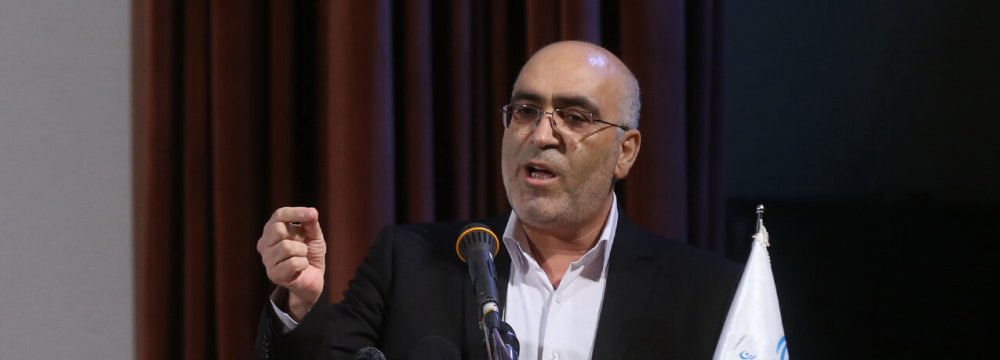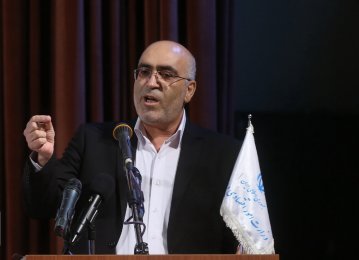Tax rates will increase by 28% on average in the current fiscal year (March 2019-20), says the head of Iranian National Tax Administration, Omid Ali Parsa.
"In underprivileged provinces, the rate will be lower. For instance, Lorestan and Ilam will witness a 15% growth. However, taxes in Tehran will rise 32%," he was quoted as saying by IRNA on Thursday in a meeting with business owners in the southern Kerman Province.
"The taxation system is moving toward imposing heavier rates on higher income deciles while minimizing levels for those with modest means," he added.
Noting that 95% of the budget go to fund civil development projects, the INTA chief said Tehran will account for 55% of the country's overall tax income in the current fiscal year, while Kerman will account for 3.2%.
The 28% rise in average tax rates comes as the Statistical Center of Iran's latest report shows the inflation rate in the country hovers around 27%.
The average goods and services Consumer Price Index in the 12-month period ending June 20 increased by 27.8% compared with the corresponding period of last year, according to SCI.
The consumer inflation for the month under review (May 21-June 20) registered a year-on-year increase of 22.5% compared with the similar month of the previous Iranian year.
The overall CPI (using the Iranian year to March 2017 as the base year) stood at 214.2 for the month, indicating a 2% rise compared with the month before.
Tax on Agriculture Sector
Parsa also said 15% of high-income producers of agricultural products will be entitled to taxation.
His comment came after the Economy Ministry proposed the abolition of agriculture sector's tax exemption as part of its comprehensive Direct Tax Reform bill.
As per the ministry's proposal, annual incomes from all agricultural activities under 600 million rials ($2,666) remain exempted from tax. Yet, if individuals gain over 600 million rials per year from such activities, the surplus amount will be subject to tax.
Mahmoud Alizadeh, the deputy head of Iran National Tax Administration, said recently that the Direct Tax Reform bill has been discussed and evaluated by the Cabinet’s Economic Commission and will soon be ratified.
“After it is approved by the Cabinet, it will head to the parliament. The bill envisages a decline in tax exemptions across different economic sectors,” he said.
The Ministry of Economic Affairs and Finance submitted to the office of first vice president its comprehensive Direct Tax Reform Bill containing new tax measures, including personal income and capital gains tax, in early 2020.
$707m Deficit per Month
While in Kerman, Parsa said INTA earns more than 120 trillion rials ($533 million) in tax revenues (direct and indirect) on a monthly basis.
“This is while the government's general expenditure is at $280 trillion ($1.24 billion) per month,” he added.
"About 8% of Iranians' income are put at the disposal of the government. The global average is at 30%. At a time when oil revenues have declined, the government has no choice but to count on tax revenues."
The Sixth Five-Year Development Plan (2017-22) targets an 8% share of tax revenues from GDP by March 2022. The figure currently stands at 6%. At present, revenues gained from tax are at least 1 quadrillion rials ($5.65 billion) behind the goals of the development plan, Fars News Agency reported.
Iran’s development plans outline government strategies in its budget planning for the next five years.
Experts say the reason for this disproportion in tax revenues’ share in the country’s GDP is that some 50% of the Iranian economy enjoy tax exemption. Add to it the rampant tax evasion and faulty taxing methods.
According to the INTA chief, 40% of Iran’s economic players are exempt from paying taxes.
Gholamali Jafarzadeh Imenabadi, a member of Majlis Plan and Budget Commission, has put the size of tax evasion at 400,000 billion rials ($1.77 billion) annually.
He has been quoted as saying that the value of tax exemption and tax evasion together is more than 1,000 trillion rials ($4.44 billion).
Independent observers put the figure at much higher rates.
Amid financial constraint, the government is counting on tax as a major source of revenue. New forms of tax have been introduced to curb the widening deficit facing the government budget.
Tax revenues increased by 31% in the last fiscal year (March 2019-20) compared with the year before to reach 1,430 trillion rials ($6.35 billion), according to Parsa.
He added that tax revenues’ share in budget increased from 37% in the fiscal 2018-19 to 54% last year, Mehr News Agency reported.
“The average growth in tax revenues over the past five years was 21% while value added tax gains hit 250 trillion rials ($1.11 billion),” he said.
Parsa noted that once the parliament gives its full consent, luxury homes and pricy cars will be subject to wealth tax.






Add new comment
Read our comment policy before posting your viewpoints